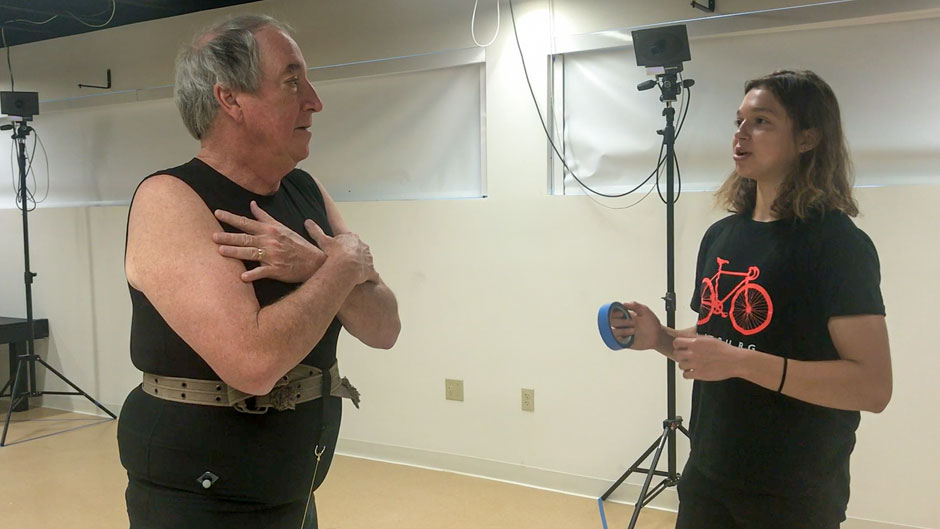Joe Sanz is an active 65-year-old. He works full time for his own commercial real estate firm, travels often, does Pilates and weight training once a week. But he has noticed that his body’s muscle mass and balance is not what it used to be.
“I used to be the one leading the paddle boarding group,” he said. “Now I fall off.”
As part of his quest to remain fit as he ages, Sanz was at the University of Miami Max Orovitz Laboratory recently getting hooked up with 16 special sensors to a small device called the Gymaware Powertool, which measures lower body power and velocity as one gets up and down from a chair.
Sanz is part of a Department of Kinesiology and Sport Sciences study led by undergraduate student Lucrezia Lucchi that will compare the Gymaware and the Tendo Unit machine, which also measures muscle power and velocity. Her hope is to collect data from 30 subjects to determine which machine more reliably assesses select variables compared to the current gold standard force plates and motion analysis system.
“Most people as they age have a fear of falling since they start to lose muscular power and their ability to react or balance quickly,” said Lucchi, who is working under the direction of Bryan Mann, professor of Kinesiology and Sport Sciences in the School of Education and Human Development. “In this study we have subjects stand up five times without using their hands.”
The Gymaware Powertool, which is hooked to the subjects’ waists, and interfaced with an iPad via Bluetooth, then assesses a host of kinetic factors, including the angle at which the person rises from the chair. Often with older people, that angle translates to an excessive forward trunk lean that can lead to imbalance and falls, said Lucchi.
By breaking down all the factors that go into the test, they are able “to tease out the different areas impacting performance and we see which areas are sufficient and which areas they could improve, allowing for more targeted training,” said Mann.
“The study is important because it can provide clinicians a more accurate way to assess their patients and the changes that they make as a result of training,” said Mann. “By breaking things down more concretely, we can get a far greater insight into the person’s performance of the movement rather than just a simple time measure from a stopwatch.”
Both the Gymaware and Tendo are less expensive and more accessible than the current force plates and 3-D imaging equipment available for physical evaluation, said Lucchi. The study will investigate which device more accurately captures the patients’ overall condition, relative to current gold standards for assessing variables. Once the study determines which equipment is the most effective for analysis, installing them in doctor’s offices and rehabilitation centers will be a goal. They will play a critical role in gathering information on the patients’ condition to be able to prescribe treatment.
During Sanz’s time at the gym, he was tethered to the Gymaware Powertool and asked to cross his hands over his chest as he sat in a chair without armrests. Then, while Lucchi and two assistants stood by, he was asked to stand five times. He did so flawlessly.
His movements were captured onto a computer as real-time power and velocity data from the Gymaware appeared on the screen of the iPad.
Lucchi aims to finish the study in mid-August for later publication. For Sanz, who has participated in other studies at UM, the study is helpful in his quest to remain active during his later years.
“I am just trying to stay in shape,” he said.

